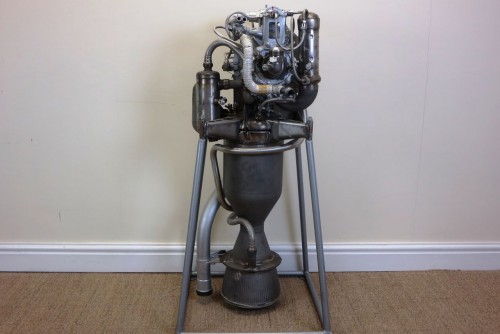
Click Here for Full Screen Image - Click Here to Download Image
 |  |  |  |  | |||||
 |  |  |  |  | |||||
 |  |
| Lot number | 138 |
|---|---|
| Hammer value | £2,300 |
| Description | Soviet surface-to-air rocket motor |
| Year | c.1957 |
| Colour | Metal |
This Russian-made rocket motor dates from c.1957 and was designed by the studio of celebrated rocket engineer, Alexei Mihailovich Isayev (1908 – 1971).
Largely self-taught, Isayev cut his teeth during World War Two on an experimental rocket-powered interceptor plane, the BI-1, which reached a speed of 615mph in March 1943 before fatally crashing, an unofficial world speed record at the time. In 1945 he was sent to Germany to acquire Nazi rocket technology and in 1947 was appointed head of his own design section, OKB-2, under the umbrella of the Scientific Research Institute of the Ministry of Aviation.
Quickly improving on the crude German technology used in the V1 and V2 rockets, Isayev came to specialise in small-scale, liquid-fuelled rocket engines for Soviet manned and unmanned spacecraft. From 1957 to 1967 his engines powered the rockets carrying the first artificial satellites, the first unmanned probes to the Moon and Venus and the world’s first manned spacecraft, the Vostok. At the same time, in the 1950s, he was working on engines for surface-to-air missiles (SAMs) and air-to-sea missiles, his best known being the R-11 ‘Scud’ missile which is still in use today. In honour of his achievements, the Isayev Crater on the dark side of the moon is named after him.
This liquid bi-propellant rocket motor is thought to be for a high altitude surface-to-air missile, similar to the one used to shoot down the supposedly invulnerable U-2 spy plane of Francis Gary Powers as he was flying over the Soviet Union on 1st May 1960 – thus bringing Soviet expertise in this area to world attention for the first time. Thought to generate some 7,000lbs of thrust (equivalent to around 1,200hp), this type of motor could propel a SAM missile to over three times the speed of sound and was to exact a heavy toll on US aircraft when supplied to the North Vietnamese forces during the Vietnam War.
Thought by the vendor to be one of only perhaps 20 such engines known to exist in ‘museum quality’ condition, it is constructed of various alloys and measures around 40ins in height and 18ins in width/depth and weighs around 140lbs including the display stand. An unusual and beautifully engineered artefact from the Cold War era, it is sure to be of interest to any collector of space or aviation memorabilia.
Stick a slab of glass on top and a light underneath and it would make a dramatic drinks table in any man cave, bar or coffee shop, as demonstrated in the last two photos of this lot on our website. Apparently never fired, it could also perhaps be fitted to a suitable vehicle and used by an enterprising individual to mount their own challenge on the world land speed record. How hard can it be; it’s not rocket science, is it? Oh, hang on…